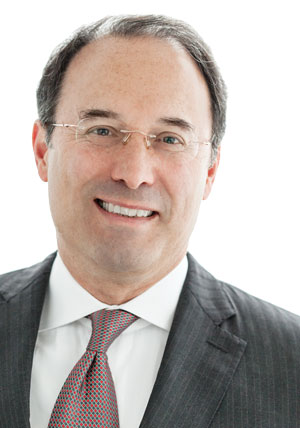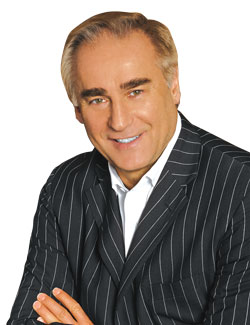More than 2,000 miles from his office on Third Avenue, Gary Barnett is quietly buying up acres of land in a locale that might seem worlds away for New York’s luxury condominium king.
The Extell Development chief has big plans for a hotel and condo project just outside Park City, Utah, according to several people in the know. And he’s one of a growing number of New York developers looking beyond the city’s borders to areas such as Portland, Oregon, St. Louis, Denver and Toronto, as it becomes increasingly difficult to make deals pencil out back home.
Of course, sponsors in the Big Apple have been looking beyond Manhattan for more than a century. San Francisco has long served as a safe haven for seasoned pros, such as Tishman Speyer, while Miami’s nickname “the Sixth Borough” remains a testament to just how comfortable New York real estate players are in South Florida. But as New York becomes a tighter market with skyrocketing land prices, and as new opportunities arise elsewhere, developers are heading to secondary and even tertiary markets for deals.
“Why go? It’s more trouble. It’s more effort. You don’t know the area as much, and you have to staff up, which makes it more expensive,” Woody Heller, the head of the capital markets group at Savills Studley, told The Real Deal. “There are only two reasons: one, you can’t find more opportunities locally, or two, the returns are better.”
Denver, for example, has become one of the fastest-growing cities in the country, with some of the strongest price growth for multi-family assets, at 26 percent, according to JLL’s first-quarter investment report for 2016. Meanwhile, Oakland, California, had the lowest office vacancy rate among the country’s urban central business districts in the first quarter, at 5.1 percent — 180 basis points lower than Midtown South’s rate of 6.9 percent.

Gary Barnett
“There are a number of markets around the country that are still growing, in part because their economies lag New York’s,” said Gabriel Silverstein, head of the Manhattan-based advisory firm Angelic Real Estate. “For those who would prefer not to buy at the top of the pricing curve, I think there is less sentiment in secondary markets that they’re at peak pricing.”
New heights
Barnett, known as one of the pioneers of New York’s ultra-luxury condo boom with One57, assembling some of the most difficult sites in Manhattan and pulling off coups like the 2014 Ring Portfolio acquisition, is now staking his claim near the Deer Valley ski resort, which is in the midst of planning a major expansion.
In January 2015, Barnett purchased roughly 40 acres of land in Wasatch County from Van Hemeyer, a Park City-based venture capitalist and developer, property records show. (Utah is a nondisclosure state, so the purchase price was not revealed.)
“It’s one of the last and closest areas to Park City that’s still developable. Then you have to go outward from there,” said Steve Blankenship, a broker with Keller Williams in Park City. The area, he said, is becoming increasingly attractive to investors as home buyers in resort towns in nearby Colorado begin to get priced out. Park City, which attracts thousands of people each year for the Sundance Film Festival, is also a magnet for celebrities and wealthy tourists.
“We see a lot of New York and New Jersey people coming out our way,” he added. “There’s going to be a lot more development going forward over the next 20 years.”
Van Hemeyer, who bought the land adjacent to the Deer Valley resort in 2010, told TRD he’s working for Extell in Utah, but declined to comment further. A representative for Extell declined to comment.
The Park City site has already been approved for a luxury hotel and 200 or more condo units, and Barnett appears to have more in store. The developer is rumored to be in negotiations to buy another 1,000 acres nearby from a consortium of Dutch investors who have owned a large tract of some 4,000 to 5,000 acres since the 1980s, according to local sources.
“It’s one of the most desirable sites adjacent to the Deer Valley resort,” said Tyler Dustman, an appraiser with Cushman & Wakefield in Park City. “It’s a new portal into the resort, so that you don’t have to go through Park City proper.”
Heading west
Barnett is not the only big-name New York sponsor heading into new territory. Steve Witkoff, a well-known name in Manhattan and Miami real estate circles, is constructing his first project in Los Angeles — a 190-room Marriott Edition in West Hollywood that will also include as many as 20 condo units.
Witkoff is developing the 13-story hotel with Vector Group CEO and Douglas Elliman Chairman Howard Lorber, his partner on 10 Madison and the Park Lane Hotel, and hotelier Ian Schrager, who launched the Edition brand with Marriott in 2007.
 Marriott bought the Los Angeles site for $31.5 million in 2012 and then sold it to Witkoff and his partners for $42.26 million in 2014. One key factor in getting the project under way was the fact that Marriott — which had worked with Witkoff on previous Edition projects in Miami and New York — offered the developer a sweetheart deal on the sale because the hotel chain wanted to bring its luxury-lifestyle brand to Los Angeles. “There would’ve been no deal without Marriott,” Witkoff told TRD.
Marriott bought the Los Angeles site for $31.5 million in 2012 and then sold it to Witkoff and his partners for $42.26 million in 2014. One key factor in getting the project under way was the fact that Marriott — which had worked with Witkoff on previous Edition projects in Miami and New York — offered the developer a sweetheart deal on the sale because the hotel chain wanted to bring its luxury-lifestyle brand to Los Angeles. “There would’ve been no deal without Marriott,” Witkoff told TRD.
He said Los Angeles has become a major destination for visitors from Southeast Asia — particularly in light of the U.S. and China allowing for multiple-entry, 10-year visas for tourists and business travelers who frequently fly between the two countries.
That agreement went into effect in November 2014.
When it comes to buying land, the average price per buildable square foot in the Los Angeles metropolitan area last year was $100 — compared to $674 in the New York metro area, according to Real Capital Analytics.
And while New York City’s hotel market is beginning to feel cramped with a flood of new supply hitting the market, Los Angeles still has plenty of runway. The sprawling Southern California city saw the most growth in revenue per available room, or RevPAR, around the country through the first four months of the year, up nearly 17 percent.
“I think the returns are going to be at least on par with what we’re doing in New York,” Witkoff said. “There certainly are projects on the drawing boards in West Hollywood, but there’s not a lot in the ground.”
Across the border
Similar to the way Witkoff got a good deal with Marriott, fellow hotel developer Henry Kallan of the Midtown-based Library Hotel Collection found favorable terms when he turned to Toronto to build what will become Canada’s largest hotel.
Kallan started developing boutique hotels in New York City in the 1990s, and now owns properties that include the Library Hotel near Grand Central Terminal, the Hotel Giraffe on Park Avenue South and the Hotel Elysee in Midtown. In 2003, the native of the former Czechoslovakia turned to his home country and developed the hotel Aria, a brand he expanded to Budapest.
Kallan is now developing the 406-room “Hotel X” near the Toronto Convention Center on a plot of land he leased from the city through a request-for-proposal process. The property, due for completion in September, will include two ballrooms, three rooftop terraces, a 250-person movie theater and an indoor sports complex.

Henry Kallan
“If this was in some place like Battery Park City, the land alone would probably cost a billion dollars,” he said.
Kallan said he and his partners, which include billionaire investor Alexander Rovt and Joshua Durst, put $100 million of equity into the project. He turned to Toronto, he said, because it provided an opportunity he couldn’t find in New York.
“I was looking outside of New York because, frankly, I’m not really in the league of some of the big players in the city,” he explained. “I don’t think I would have the same opportunity in New York to do this project.”
Anytown, U.S.A.
Still, others are turning to more far-flung markets purely to expand their reach and further their growth.
“It’s no big secret that New York cap rates are very low and prices are very high,” Time Equities CEO Francis Greenburger told TRD. “For us, New York is difficult to buy in, and the cycle is also pretty mature. There are other markets where it’s less mature.”
Time Equities began searching for other markets 30 years ago, simply as part of “a normal diversification discipline that one brings to any investment portfolio,” he said. One current project is in Chicago, where the firm is developing a 60-story condo tower designed by starchitect Helmut Jahn.
“There’s limited condominium construction in the Chicago market, therefore we think it might be an opportunistic time to create some supply,” Greenburger explained.
And outside St. Louis, Time Equities is buying a 111,000-square-foot suburban office property out of foreclosure for $30 per square foot. The asset is about 50 percent leased, which provides an opportunity to reposition the tenant base, Greenburger said.
“Right now, the suburban office market is challenged in many places,” he added. “As a result, it’s also trading at attractive prices.”
Portland is another area that is beginning to attract New York investors, due to the strength of its residential market. The city led the country in terms of home price growth with year-over-year gains of 11.8 percent in March, according to the S&P/Case-Shiller index.
That makes the barrier to homeownership higher, making multifamily assets more attractive. Portland was second only to Seattle in terms of rent growth on the West Coast, at 7.5 percent, according to JLL.
And the city’s central business district also had one of the lowest vacancy rates in the nation during the first quarter of the year, at 6.5 percent compared to 6.9 percent in Midtown South.
New York state of mind
New York-based GFI Capital Resources, which has been active in Kansas City’s multifamily market for about a decade, is currently making “significant offers on deals” in Portland, the firm’s president Allen Gross said.
GFI is also setting its sights on Denver, which has one of the fastest-growing populations in the country. The Colorado city saw its multifamily pricing climb 26 percent year-over-year in the first quarter, compared to the 20 percent growth in the five boroughs in the same period.
“There are approximately 2,000 people moving to Denver every month,” Gross said. “That’s the kind of thing we follow.”
But doing deals outside of the five boroughs can take some adjustment.
“When you’re on the plane, you have to take off your New York hat, everything works differently,” Gross said, noting that in a city like Houston, which has notoriously lax zoning laws, it’s difficult to predict how markets will evolve.
Others noted that markets with low barriers to entry are more susceptible to oversupply, while those with low sales volumes can be problematic for owners with relatively short exit plans.
In New York, Gross explained, the dream is to buy property, create value and leave it for your grandchildren. Outside of the city, he said, the idea is to “buy, create value and get the hell out.”
